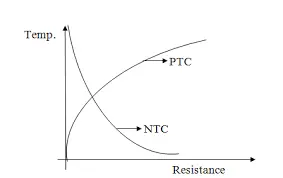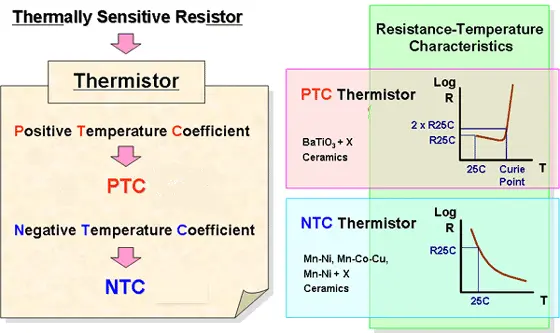NTC thermistors and PTC thermistors are two common types of electronic devices used for temperature sensing and control. These specialized resistors offer distinct characteristics and applications, making them essential components in various industries. This article will explore the differences between NTC thermistors, which exhibit a negative temperature coefficient, and PTC thermistors, which exhibit a positive temperature coefficient, highlighting their unique properties and uses in temperature-related applications.
Quick Answer: The main difference between NTC and PTC thermistors is their resistance response to temperature changes: NTC thermistors decrease resistance when heated (Negative Temperature Coefficient), while PTC thermistors increase resistance when heated (Positive Temperature Coefficient). This fundamental difference determines their ideal applications in temperature control and circuit protection.

Part 1. What is a thermistor?
A thermistor is a sensor that measures temperature. It consists of semiconductor materials such as metal oxides or ceramics. When the temperature changes, the thermistor’s electrical resistance changes, too, which helps us know how hot or cold something is.
There are two main types of thermistors: positive temperature coefficient (PTC) and negative temperature coefficient (NTC). PTC thermistors get more resistant as they get hotter, while NTC thermistors get less resistant as they get hotter.
Part 2. Why do lithium batteries need thermistors?
Temperature Monitoring
Thermistors help monitor the temperature of lithium batteries. It can be dangerous if a battery gets too hot or cold. High temperatures can lead to overheating and even explosions in extreme cases. Freezing temperatures can make the battery less efficient and cause damage over time. Thermistors monitor the battery’s temperature and alert the device to take action if it’s too hot or cold.
Overheat Protection
When lithium batteries are being used or charged, they can sometimes generate heat. Mismanagement of this heat can lead to problems. Thermistors help prevent overheating by monitoring the temperature and signaling the device to stop charging or reduce power if necessary. This protects the battery from damage and ensures it lasts longer.
Battery Life Optimization
By keeping the temperature in check, thermistors help prolong the life of lithium batteries. Excessive heat can degrade the battery, reducing its capacity and lifespan. Thermistors help optimize the battery’s performance and longevity by maintaining a safe temperature range.
Part 3. NTC Thermistors
Characteristics
- Temperature Sensitivity: NTC thermistors exhibit a high sensitivity to temperature changes, making them ideal for accurate temperature measurements.
- Resistance-Temperature Relationship: As the temperature increases, the resistance of NTC thermistors decreases. This negative temperature coefficient behaviour is essential for their temperature sensing capabilities.
- Nonlinear Response: NTC thermistors have a nonlinear relationship between resistance and temperature. The resistance change is most significant at lower temperatures, allowing for precise measurements in a specific temperature range.
Working Principle
NTC thermistors operate based on the behaviour of certain semiconductor materials. These materials exhibit properties where the number of charge carriers increases as the temperature rises. Consequently, the increased thermal energy enhances the conductivity and decreases the resistance of NTC thermistors. This characteristic enables them to accurately sense and measure temperature variations in a given environment.
Applications
- Temperature Measurement and Control: NTC thermistors are commonly used in temperature sensing and control applications, such as integrating them into thermostats for HVAC systems, refrigerators, and water heaters.
- Overheat Protection: They are utilized in electronic devices and systems to prevent overheating by monitoring temperature levels and triggering safety mechanisms if temperatures exceed safe limits.
- Battery Management: NTC thermistors are integrated into battery packs to monitor the temperature of lithium-ion batteries, ensuring safe charging and discharging operations.
- Automotive Systems: NTC thermistors are employed in automotive applications to monitor engine temperature, coolant temperature, and cabin temperature control.
- Medical Devices: They find use in equipment for body temperature monitoring, including thermometers and incubators.
- Industrial Process Control: NTC thermistors are crucial in industrial temperature sensing and control processes, ensuring optimal operation and product quality.
Part 4. PTC Thermistors
Characteristics
- Positive Temperature Coefficient: PTC thermistors exhibit an increase in resistance as the temperature rises beyond a specific temperature threshold.
- Sharp Resistance Transition: PTC thermistors sharply increase resistance once the temperature exceeds the threshold, resulting in nearly constant resistance above that point.
- Limited Sensitivity: PTC thermistors offer less sensitivity to temperature changes than NTC thermistors.
- Self-Resetting: These thermistors can self-reset once the temperature drops below the threshold, allowing them to protect against overcurrent or overtemperature conditions.
Working Principle
The working principle of PTC thermistors relies on the behaviour of ferroelectric ceramics. As the temperature increases, these ceramics undergo a phase transition, leading to a sudden increase in resistance. This behaviour allows PTC thermistors to act as self-resetting fuses or components that limit current flow during overcurrent or overtemperature conditions.
Applications
- Temperature Sensing and Control: PTC thermistors are commonly used in temperature sensing and control applications, such as integrating them into thermostats for household appliances like heaters and air conditioners.
- Overcurrent Protection: They are employed in electronic circuits to provide overcurrent protection. The increase in temperature triggers a self-limiting effect, reducing current flow to prevent damage to components.
- Motor Starting Devices: PTC thermistors serve as motor starting devices in various equipment, such as refrigerators and air compressors. They provide a high initial resistance that decreases as the engine starts, ensuring smooth operation.
- Inrush Current Limiting: People utilize PTC thermistors to limit inrush currents in power supplies and electronic devices during startup, preventing damage to components and enhancing system reliability.
- Battery Protection: They find applications in battery packs to protect against overcharging and over-discharging by controlling the charging and discharging currents based on temperature changes.
- Temperature Compensation: PTC thermistors are used for temperature compensation in electronic circuits, ensuring stable performance of components over a wide temperature range.
Part 5. NTC vs PTC Thermistor: Key Differences Chart
| Feature | NTC Thermistor | PTC Thermistor |
|---|---|---|
| Temperature Coefficient | Negative (Resistance ↓ as Temp ↑) | Positive (Resistance ↑ as Temp ↑) |
| Response Speed | Fast (50-100ms) | Moderate (100-300ms) |
| Accuracy Range | ±0.1°C to ±1°C | ±2°C to ±5°C |
| Typical Applications | Precision temp sensing, Battery monitoring | Overcurrent protection, Motor startup |
| Cost | $0.10-$1.00/pc | $0.20-$2.00/pc |
| Self-resetting | No | Yes |
| Common Materials | Mn, Ni, Co oxides | BaTiO3-based ceramics |
Part 6. Technical comparison: NTC vs PTC thermistor performance
1. Resistance-Temperature Relationship:
- NTC thermistors exhibit a negative temperature coefficient, meaning their resistance decreases as the temperature rises.
- PTC thermistors exhibit a positive temperature coefficient, causing their resistance to increase as the temperature rises beyond a specific threshold.
2. Sensitivity to Temperature Changes:
- NTC thermistors are highly sensitive to temperature changes, allowing for precise temperature measurements.
- PTC thermistors offer limited sensitivity to temperature changes compared to NTC thermistors.
3. Resistance Transition Behavior:
- The resistance of NTC thermistors changes nonlinearly with temperature variations, with the most significant resistance change occurring at lower temperatures.
- PTC thermistors exhibit a sharp resistance transition once the temperature exceeds a specific threshold. Above this threshold, their resistance remains nearly constant.
4. Self-Resetting Capability:
- NTC thermistors do not possess self-resetting capabilities. Their resistance continuously varies with temperature changes.
- PTC thermistors have self-resetting capabilities. Their resistance decreases when the temperature drops below the threshold, allowing them to reset automatically.
5. Applications:
- NTC thermistors are commonly used as temperature sensors, temperature compensation devices, heating elements, and temperature monitors in various industries, such as automotive, HVAC, and medical.
- People often use PTC thermistors for overcurrent protection, motor starting devices, temperature-controlled switches, overtemperature protection, and automated heating elements in consumer electronics and appliances.
Part 7. FAQs: NTC vs PTC Thermistor
Q: Which is better for temperature sensing: NTC or PTC?
A: NTC thermistors are generally preferred for precise temperature measurement due to their higher sensitivity and faster response time…
Q: Can PTC thermistors replace fuses?
A: Yes, PTCs often serve as self-resetting fuses in circuits. When overcurrent occurs…
Q: How to choose between NTC and PTC?
A: Consider these 3 factors:
1. Required temperature range (-50°C~150°C: NTC; 60°C~250°C: PTC)
2. Accuracy needs
3. Reset requirements
Part 8. Conclusion
NTC and PTC thermistors are two distinct types with contrasting characteristics and applications. NTC thermistors exhibit a negative temperature coefficient, offering high sensitivity and precise temperature measurements. In contrast, PTC thermistors have a positive temperature coefficient and provide self-resetting capabilities for overcurrent and overtemperature protection. Understanding the differences between these thermistors allows for informed selection and optimal utilization in various temperature-related applications.
Related Tags:
More Articles

LiPo Battery Discharge Rate Guide & Calculation Tips
Understand LiPo battery discharge rates, C-ratings, and how to calculate max current. Essential guide for RC, drones, and electronics users.
High‑Capacity 3S LiPo Batteries: 5000 mAh vs. 10000 mAh
Compare 3S LiPo 5000mAh vs 10000mAh batteries by weight, power, and use. Find the best fit for your drone, RC car, or boat setup.
Top 5 Applications for Small 3S LiPo Batteries
Small 3S LiPo batteries power drones, RC gear, wearables, and robotics with high energy and low weight. Making them ideal for compact electronics projects.
Building and Charging Your Own 3S LiPo Pack: A Step‑by‑Step Guide
Learn how to build, balance, and charge a 3S LiPo battery pack safely at home with this complete DIY guide for hobbyists and beginners.
How to Choose the Right LiPo Battery Plug Type?
Discover the best LiPo battery plug types, how to choose them, and expert tips for safe usage, soldering, and maintenance.




